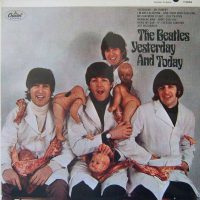
Producer: George Martin
Engineers: Norman Smith, Geoff Emerick
Released: 15 June 1966
Personnel
John Lennon: vocals, electric guitar, acoustic guitar, piano, harmonium, tambourine, handclaps
Paul McCartney: vocals, electric guitar, acoustic guitar, bass guitar, handclaps
George Harrison: vocals, electric guitar, acoustic guitar, maracas, tambourine, handclaps
Ringo Starr: vocals, drums, cowbell, tambourine, percussion, handclaps
George Martin: piano
Tony Gilbert, Sidney Sax: violin
Kenneth Essex: viola
Francisco Gabarro: cello
Tracklisting
‘Drive My Car’
‘I’m Only Sleeping’
‘Nowhere Man’
‘Doctor Robert’
‘Yesterday’
‘Act Naturally’
‘And Your Bird Can Sing’
‘If I Needed Someone’
‘We Can Work It Out’
‘What Goes On’
‘Day Tripper’
Yesterday… And Today was The Beatles’ tenth album released by Capitol Records in the USA. It became notorious for its initial artwork, the ‘butcher cover’ which was swiftly withdrawn from sale.
I don’t know how it came about. I don’t know how we ended up sitting in butchers’ coats with meat all over us. If you look at our eyes, you realise none of us really knew what we were doing. It was just one of those things that happened as life went on.The sleeve was great for us because we were quite a nice bunch of boys and we thought, ‘Let’s do something like this!’ What was crazy about that sleeve was that, because it was banned, they glued paper over it and everyone started steaming it off. They made it into a really heavy collector’s item – which, I’m afraid to say, I don’t have a copy of, because in those days we never thought, ‘We’d better save this.’
The artwork showed The Beatles wearing butcher coats, surrounded by raw meat, false teeth, and disembodied doll parts. Although interpreted by some as a commentary on Capitol’s tendency to chop and change their album running orders for the US market, the shoot, by photographer Robert Whitaker, was not originally intended for an album cover, and was part of a wider triptych known as ‘Somnambulant Adventure’.
The 1966 American album, Yesterday And Today, was the one with the controversial sleeve. I think Brian Epstein had met a photographer in Australia called Robert Whitaker, who came to London where Brian introduced him to us. He was avant-garde and took a lot of photographs. He set up a photo session which I never liked personally at the time.I thought it was gross, and I also thought it was stupid. Sometimes we all did stupid things, thinking it was cool or hip when it was naïve and dumb; and that was one of them. But again, it was a case of being put in a situation where one is obliged, as part of a unit, to co-operate.
So we put on those butchers’ uniforms for that picture. In the photograph we’re going, ‘Ugh!’ That’s what I’m doing, isn’t it? I’m disgusted, and especially so by the baby dolls with their heads off. What the bloody hell is that all about?
Quite rightly somebody took a look at it and said, ‘Do you think you really need this as an album cover?’ So the record company said: ‘You don’t want to do a cover like that. We want to have a nice one with you all sitting in a little box.’
Yesterday… And Today contained eleven songs. ‘Yesterday’ and ‘Act Naturally’ were previously released on the UK album Help!, and had been issued as a single by Capitol on 13 September 1965.
‘Drive My Car’, ‘Nowhere Man’, ‘If I Needed Someone’, and ‘What Goes On’ were recorded for Rubber Soul, but omitted from Capitol’s version.
The remaining songs included the standalone double a-side single ‘We Can Work It Out’/‘Day Tripper’, and three John Lennon songs recorded during the Revolver sessions and sent to Capitol for early release: ‘Doctor Robert’, ‘And Your Bird Can Sing’, and ‘I’m Only Sleeping’.
Yesterday… And Today was issued in mono and stereo. The mono mixes of the new songs were different from those used on the UK Revolver album, and initial stereo copies contained duophonic ‘mock stereo’ versions of the songs. Later pressings used true stereo mixes.


Can’t really find any real information about my personal copy. Is anyone able to tell me about it?
Details:
Mono copy, Trunk cover (100% sure.) Scranton pressing, rainbow label. My copy lacks an RIAA number. Matrix runouts are:
Side 1: T1-2553-G6#4
Side 2: T2-2553-G2#3
Discogs listing for an RIAA-numberless mono Scranton copy lacks any pricing details, and the only listed runout matrix numbers are T1-2553-G2/T2-2553-G4#2. The only match for the matrix number was a listing for a 3rd-state peeled butcher and those have the RIAA designation 6.
(Sorry if this all looks like a load of nonsense. It’s a little hard to describe something when you can’t find any information on your particular copy. There’s just so many Capitol variants, it hurts the head.)